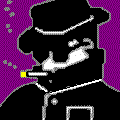
Tasked with investigating which of his trusted former colleagues has chosen to betray him and their country, Smiley narrows his search to four suspects—all experienced, urbane, successful agents—but past histories, rivalries and friendships make it far from easy to pinpoint the man who is eating away at the heart of the British establishment.
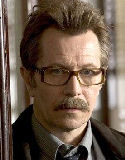 |
 |
 |
 |
 |
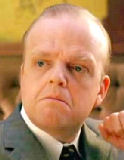 |
 |
| Gary Oldman George Smiley (Beggerman) |
Colin Firth Bill Haydon (Tailor) |
Mark Strong Jim Prideaux |
Benedict
Cumberbatch Peter Guillam |
Ciarán
Hinds Roy Bland (Soldier) |
Toby Jones Percy Alleline (Tinker) |
David Dencik Toby Esterhase (Poorman) |
| Tom Hardy |
. . . . . |
Ricki Tarr |
| John
Hurt |
.
. . . . |
Control |
| Svetlana Khodchenhova |
. . . . . |
Irina |
| Kathy Burke |
. . . . . | Connie Sachs |
| Stephen Graham |
. . . . . | Jerry Westerby |
| Roger Lloyd Pack |
. . . . . | Mendel |
| Christian Mackay |
. . . . . | |
| Simon McBurney | . . . . . | Oliver Lacon |
(Telegraph, Sept 3, 2011, by Mick Brown) Read complete article here
The actor and the spy—think how much they have in common. The blurring of identity, the art of disguise, the ability to become somebody else and to play that part convincingly. Acting, so often said to be an investigation of ‘the truth’ is, like so much intelligence work, actually the concealment of a lie.
Seated in his caravan on the set for the new film adaptation of John le Carré’s seminal Cold War thriller Tinker, Tailor, Soldier, Spy, the actor Gary Oldman is talking about getting to grips with the role of George Smiley, the master spy.
Smiley is one of the truly great creations of post-war English literature: a nondescript man of late middle age who confounds every stereotype of the spy as man of action; a man, as le Carré has it, with ‘a past so complex that he himself could not remember all the enemies he might have made’, whose weapons are a beady eye and a profound understanding of human fallibility. As Sherlock Holmes is to the world of detection, so George Smiley is to the world of espionage.
Oldman is dressed for the part in a grey tweed three-piece suit, a shirt and tie, and the horn-rimmed spectacles which, it seems, are the key to incarnating the character of Smiley. ‘I tried on hundreds of pairs,’ he says, ‘and then you know in five seconds…’ He pauses, in search of the appropriate metaphor. ‘They are the Aston Martin.’
His manner is pensive, watchful, his movements contained. It is almost as if he is wearing George Smiley. ‘This role is very much about stillness,’ he says. ‘There’s a point in the book where Smiley’s wife, Ann, describes him as being like a swift, that he can lower his body temperature till it’s the same as the environment, then he doesn’t lose energy adjusting. Not to sound all methody, but it’s like my blood pressure’s dropped. Maybe I’m the swift.’
Ostensibly based on le Carré’s own experiences in the intelligence services, Tinker, Tailor, Soldier, Spy was published in 1974, at a time when the Cold War was at its height, and the betrayals of the so-called Cambridge Five—Kim Philby, Donald Maclean, Guy Burgess et al—were still fresh in the nation’s collective memory. The death of a British agent on a botched operation in Czechoslovakia has led to suspicions that a Soviet mole has penetrated the highest echelons of MI6. Smiley, a senior officer who has been forced into retirement with the coming of a new hierarchy, and who has ‘given himself full time to the profession of forgetting’, is approached to surreptitiously root out the mole among his erstwhile friends and associates. ‘It’s the oldest question of all, George,’ as Lacon, the senior civil servant who has brought Smiley in out of the cold, puts it. ‘Who can spy on the spies?’
Tinker, Tailor is a thriller almost devoid of action in the conventional sense. What le Carré describes is a cerebral chess game in which the inner sanctum of ‘the Circus’, as he calls the Secret Service, is a labyrinth of mirrors in which nobody is quite what they seem, everybody’s motives are open to question and nobody can be trusted. In modern spy stories, everybody hurries. Here, when Smiley interrogates someone, time ticks away ‘without anyone using it’. He is a man who ‘preferred to let the silence do its work, and he seemed confident it would’. [...]
The idea of a film adaptation of Tinker, Tailor was first bruited by the screenwriter Peter Morgan, best known for writing the films The Deal, The Queen and Frost/Nixon. ‘He suggested, and we all agreed, that doing a Cold War film 20 years after the Wall coming down was a great idea,’ Tim Bevan, the film’s producer, says. ‘And basing it on one of the great literary pieces that depicted that seemed to be a very sensible proposition.’
Working closely with le Carré, Morgan wrote a couple of drafts, before pulling out to concentrate on other things. The script passed into the hands of Peter Straughan and Bridget O’Connor, who more or less started again from scratch. ‘The one thing Peter had proved to us is that you could absolutely tell the story in 120 minutes,’ Bevan says.
Bevan had talks with a number of British directors about the project, but the formidable legacy of the BBC series and what he calls ‘the Alec Guinness of it all’ made them nervous. ‘I never saw that personally,’ he says. ‘I always just thought that this was a fantastic story, and if it was made for television 30 years ago, so what?’
A solution presented itself in the person of Tomas Alfredson, the Swedish director whose film Let the Right One In, a dark meditation on the relationship between a troubled young boy and a vampire girl, became an international success in 2008. ‘He came to see me,’ Bevan says, ‘and I was expecting some 20-year-old cool dude, and in wandered Tomas, who is not a 20-year-old dude, but is a very cool and a very interesting man.’ [...]
What struck Alfredson then, he says—and what continues to intrigue him now—is the difference between the ‘ideal soldier’ for the Cold War and for a ‘hot’ one. ‘It felt like the spy world was a very feminine world, even though it was mostly men involved. It’s about feelings, intuition, the ability to play around with the imagination—stuff you really don’t need on the beaches of Normandy. Being a foreigner, there’s a fascination for me about this former empire that still lives with the idea that they are rulers of the world, and about the endurance of the British “code” of behaviour and how these people communicate with each other. For instance, in the last scene in the film when Smiley has revealed the mole they still shake hands and they’re very polite and Smiley says, “Anything I can help you with…” And, of course, it’s a brilliant piece of literature,’ he laughs, ‘and totally impossible to put into a film, and that’s something that also makes you want to do it.’
The production has taken over a disused Army barracks in north London, a more economical option than renting studio space, and one that also offers an infinite variety of usage. The old administrative block now houses the film’s design studios and production offices (where a photograph of Kim Philby is pinned on the door like some abiding patron saint of betrayal). Corridors and alcoves have been used for interior shots, and the side of a building has been ‘dressed’ as the exterior of a Wimpy bar.
In le Carré’s book ‘the Circus’ takes its name from Cambridge Circus in London’s West End, where its headquarters are ostensibly located. In the book, and in the TV adaptation, these premises were depicted as cramped warrens of faded Edwardian gentility, with muddy-green walls and scenes of England prints, pervaded by the smell of ‘sweet dust and jasmine tea’. For the film, the production designer Maria Djurkovic has reimagined the HQ as a 1970s block, secreted within a complex of Edwardian buildings, and brought a period hi-tech modernism to the interiors.
In one corner of a warehouse, a conference room has been constructed, padded with sound-insulation foam; on a glass-topped table stands a whisky decanter and an ashtray brimming with cigarette butts. There is a large open-plan office where the admin staff and secretaries (‘the mothers’, as le Carré had it) sit, rows of wooden desks with ancient typewriters and empty wastepaper bins upturned on their surface (in keeping with service protocol), and a single early-model Wang word processor (the 1200 model, introduced in 1974). Authentic period posters are pinned to the wall: remember—telephone talk is not secure; what the hydrogen bomb does.
In another building, Alfredson has been filming a scene where Smiley and his righthand man, Peter Guillam (Benedict Cumberbatch), arrive at the shabby terrace house where ‘the mole’ conducts his clandestine meetings with his Soviet contact. It is a short scene, merely showing the two men entering the house; a moment of consternation from the housekeeper, a dog leaping excitedly on to a sofa at the arrival of strangers. ‘Be quiet, dog,’ the housekeeper says. (Actually the dog is, on command, being quiet. The barks will be overdubbed later.)
Bevan says, ‘You kind of know what the movie would have been like with virtually any English director, and the fact is you didn’t with Tomas. Oftentimes the best films about places are made by people who don’t come from there. I remember Nic Roeg saying that the brilliant thing about making Walkabout was that he didn’t know anything about Australia, and the film was his journey of getting to know the country. And I think for Tomas his journey in getting to know England through making this movie is one the audience will take through the film as well.’
Alfredson has assembled a stellar cast of British actors, including Colin Firth (who plays Bill Haydon, the suave, insouciant agent at the heart of the conspiracy), Cumberbatch, Mark Strong and John Hurt. But it was laying to rest what Alfredson calls ‘the Alec Guinness ghost’ that was to prove the most difficult challenge. ‘It was an almost impossible problem to solve,’ he says. ‘I think we sat nearly a year without any ideas. We couldn’t go with someone almost like Alec Guinness—that would not be fair to that actor, or to Sir Alec. So I felt we needed to have another silhouette, another energy, another body, but yet George Smiley.’
Alfredson says he casts his films by envisaging his principal characters as animals. ‘So this is a fox, this is a snake, this a frog—not the image of a frog, but the soul of a frog. This way you are much freer to choose from different ages and types.’ Smiley, he says, is ‘a turtle, because the turtle has so much of its body hidden inside a shell; it is fixed, and it doesn’t have a lot of different expressions.’
Gary Oldman, an actor for whom the adjective ‘kinetic’ might have been invented, does not seem the most obvious choice to fit this description. Having made his early reputation as one of the outstanding young English actors of his generation with films such as Sid and Nancy and Prick Up Your Ears, in more recent years Oldman has been living in Hollywood, playing villains and larger-than-life roles in ‘franchise’ films such as Batman and Harry Potter.
‘He is a different type, and yet the same soul,’ Alfredson says of Oldman. ‘He has invested a whole career in order to get this face, this voice, to get the experience to play… nothing—which is the hardest thing you can ask an actor to do.’
Oldman says he hesitated about stepping into the shoes of Guinness—‘but not for long. The chance to play a character that’s internal and quiet was one that ultimately I couldn’t say no to. I’m in no way putting myself in the same league, but you’ve got Guinness and you’ve got Gary, and there’s 30 years or something between them, but there’s a road map that we’re both following; and anyone with a modicum of talent or instinct will walk that path.’
For Oldman, the most important signs on the map have come from le Carré (or to give him his proper name, David Cornwell) himself. ‘You read the book, you read the script and then you meet David, and his signature is in all those characters, but specifically it’s in Smiley. And I’ve taken some things from him—a few mannerisms, a certain inflection in the speech. It began as an impersonation and I’ve worked it through my own filter. I suspect Guinness took something from him, too.
‘Smiley is someone who melts into the furniture. And sometimes you don’t want anything at all to read in the eyes. There are times when he looks almost bored—and that’s when you know he’s interested. So it’s been a great joy in that sense, and challenging, because so much of it is internal.’
Oldman says that Tinker, Tailor is the kind of thoughtful, intelligent, well-crafted film that comes along all too rarely. ‘It’s an intellectual thriller. And I was amazed at the script. It’s very refreshing that it’s as faithful as it can be to the book given that we have two hours to tell it rather than six hours.’
‘You need to choose what to put the magnifying glass on,’ Alfredson explains. ‘This story is about betrayal, in a very private way, between friends and people you’re supposed to trust. So we have done a film that’s extremely close to the characters, and much less about the Cold War or the politics.’
In Alfredson’s film the sense of intrigue and emotional tension—and of time ticking away without anyone using it—is stretched as tight as a piano wire. ‘It’s a tricky thing, this,’ he says with a slight smile. ‘It’s one thing to depict boredom, but what you don’t want is to be boring.’
The sense of period is superbly evoked—a pre-digital world of telephone boxes, clunking great tape-recorders, of rain, austerity and gloom. ‘The gloom is important,’ Alfredson says. ‘But it’s a nice gloom, for some reason. That was a very strong memory for me of coming here for the first time in 1973. If you see London now and at that time, it’s two different cities. Today it’s a white city, then it was black; it was so dirty, and you could still feel the war all around. And I think we’ve captured that.’ Bevan describes Tinker, Tailor as feeling ‘like a film that was made in the 1970s, rather than a film about the 1970s’, the stylistic equivalent to such classic films of the period as Coppola’s The Conversation and Bertolucci’s The Conformist.
Le Carré, who is credited as an executive producer on the film, has played an almost oracular role in its making. All of the principal actors have sat down with him at one time or another, picking his brains about service procedure, slang, the pressures of living in a constant state of anxiety. ‘Waiting for the noise of the shoes on the stairs,’ Oldman says. ‘David talked about that. It’s one of the things he remembers very vividly. The fear of their cover being blown.’
Cumberbatch, who plays Guillam, the young officer who aids Smiley in tracking down the mole, describes his meeting with le Carré as ‘priceless. He has a very full vision of that world and the history of the character, so it’s all there on a plate for you after having a conversation with him.’ In preparation, Cumberbatch had taken himself off, alone, to the Moroccan seaside town of Essaouira. Le Carré makes mention in the book of Guillam having been stationed in Morocco, and Essaouira, with its maze of narrow streets, its long shadows, its window shutters banging in the wind blowing off the Atlantic, provided a perfect setting for the cultivation of feelings of unease. ‘It’s got a slightly nightmare quality,’ Cumberbatch says, ‘and I was wandering around the streets at night, thinking what it must be like to know that every turn could be my last. It was very helpful.’
For Alfredson it was le Carré’s benediction that finally assuaged his early concerns about whether to make the film at all. ‘He said, please don’t do the book and please don’t do the TV series; they already exist. And the man is like a living encyclopaedia—and so friendly, interested, updated; he’s one of the youngest people I’ve ever met, although he’s 80 this year. Just a fantastic person.’ Alfredson recalls one occasion when he was shooting a particularly critical scene in the film where the inner circle of the Circus are gathered around the conference table. ‘When we rehearsed it, it felt as if Bill Haydon should say something, but what would he say? Well, why not call John le Carré and see if he’s in? And we called him and we described the situation. He thought for 15 seconds and he said, grab a pen, here it is. It was a fantastic moment.’
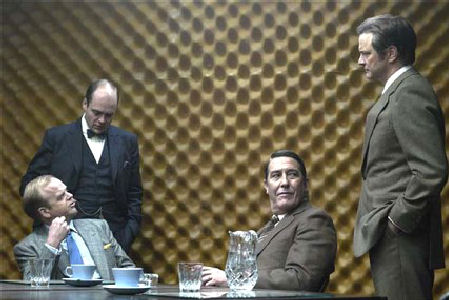 ‘I almost expected it to be brought in on a velvet
cushion,’ Colin Firth, who plays Haydon, says. He laughs. ‘Your line…
fresh from the maestro.’
‘I almost expected it to be brought in on a velvet
cushion,’ Colin Firth, who plays Haydon, says. He laughs. ‘Your line…
fresh from the maestro.’Firth says he has closely modelled his depiction of Haydon on Kim Philby (whom le Carré once described as ‘spiteful, vain and murderous’). ‘Le Carré doesn’t say that Philby was the inspiration for Haydon, but I’ve decided to tie him to Philby.’ With Alfredson, Firth studied newsreel footage of Philby’s infamous 1955 press conference following the defection of Burgess and Maclean, in which Philby denied he was ‘the third man’—seven years before he fled to Moscow. ‘You can see the tremendous tension in his body language and in his facial expression, but he cannot hide the sense of mischief. The image of the Russian doll-within-a-doll that Smiley applies to Haydon comes to mind when you look at someone like Philby, because you don’t ever quite get to the bottom of his motivation.’
One of the intriguing things about Tinker, Tailor, Firth says, is that it takes place against the background of the Empire’s decline, and the clash of ideologies which—a mere 40 years on—already seems curiously like ancient history. ‘One can be almost nostalgic about the Cold War now. The idea of it being so complicated, but somehow ideologically seeming so simple, particularly as we look at the West now and question whether capitalism really did win that struggle. The last rites were pronounced on Eastern European communism, but we’ve yet to see who was really the biggest loser.
‘John le Carré has been attacked for just writing for men and being “completely unemotional”,’ Firth goes on, ‘but looking at this story now I think it’s profoundly emotional; the sense of melancholy is huge. David has described Smiley as the ultimate disappointed romantic, and one of the things the film picks up very strongly is that he wants to believe in these incredibly simple, and arguably rather sentimental, values, and yet he’s constantly disappointed.’ [...]
The call has come for Oldman to be on set. For a moment he sits quite still, as if summoning the spirit of Smiley. It’s odd, he says at last, how over the last few months he has found himself becoming more watchful, more introspective. ‘Not so chatty… My wife said to me the other day, “Are you listening to what I’m saying? I’ve been talking to you for about an hour? Are you going to engage?” Because I think I was sort of drifting away.’
He adjusts his glasses, and rises from his seat. ‘I think I’ll miss him when this ends.’
(Daily Mail, July 10, 2011, by Martyn Palmer)
John le Carré reflects on the Cold War world of his definitive espionage novels and the British film event of the year, as interviewed by Pip Ayers. The article in its entirety here.
* * * *
* *
Colin Firth on those leading a double life (the Oscar-winning actor returns to the big screen in the British film event of the year):
‘I play (London Station chief) Bill Haydon, one of the five people at the top of the operation at the Circus who could be the mole. Haydon has a lighter approach than the others; he’s a joker and somewhat predatory and he’s known to be a bit of a boy when it comes to the girls—and indeed the boys. There’s a sense of mischief and sleaze about him, but he’s also charming and urbane.
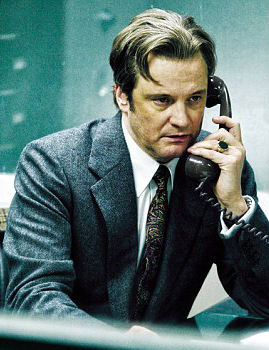 ‘I
was riveted when I watched Tinker, Tailor on television in the
Seventies. That led me to read some of le Carré’s other books,
like The Spy Who Came In From The Cold. I found putting the pieces
together was exciting. I found the characters incredibly vivid.
‘I
was riveted when I watched Tinker, Tailor on television in the
Seventies. That led me to read some of le Carré’s other books,
like The Spy Who Came In From The Cold. I found putting the pieces
together was exciting. I found the characters incredibly vivid.‘The thing that keeps coming up in book after book is how lonely these characters are. I don’t want to sound too airy-fairy when I talk about the book, but that urban melancholy and isolation in a very sophisticated, rather merciless world is, I think, the thing that actually hits the spot with readers.
'In Tinker, Tailor these guys are all hardbitten, highly trained, extremely unsentimental and all somehow disappointed idealists or bruised.
‘It was a bit like God visiting when le Carré appeared on set for the Circus party scene. He is the man who created the world that you are in, incarnate right there among you. Everything you’re saying, the clothes you’re wearing and the characters you’re playing are all products of this man’s incredible imagination.
‘I’ve known le Carré for some years and we’ve had lunch together a couple of times. He is one of the most erudite, interesting, civilised dining companions I’ve ever known. He has an extraordinary grace. I also think he has enormous humanity. He is a man whose imagination is very much alive— you know there isn’t a banal or conservative (with a small ‘c’) bone in his body. He constantly seems to be rethinking and challenging received wisdom.
‘Britain, like every nation, chooses for her spies people who are brilliant at complicity, people who have grown up and been groomed into a double life.
'The first play I ever did, Another Country, tried to come up with a theory as to how that particular generation of spies became spies. And it was a) the fact that they were concealing being gay, and b) they had an axe to grind with the Establishment.’
* * * *
* *
* * * * * *
Gary Oldman on playing
George Smiley, the world-weary British spy
When Gary Oldman learned that he would be playing world-weary British spy George Smiley, he knew the best research would be to ask a real spy what the Cold War was like. The man he asked spent six years, from 1958 to 1964, tapping phone lines, stealing information and running secret agents for both MI5 and MI6. He was David Cornwell, better known as John le Carré.
‘Britain has always had spies and I think we’ve spied rather well,’ says Oldman, 53. ‘But we have a rather romantic view of it and le Carré was the first to really show the reality.
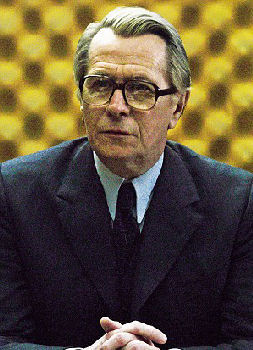 ‘He told
me that you would be given an assignment and go to Russia or to
Czechoslovakia. You would be sent to watch someone. You would be in
some miserable little room with a fake ID, and it would be very lonely
and often very boring. He said that the terror of having your cover
blown was exhausting: you were always waiting for the footsteps on the
stairs. I guess that’s why so many of them hit the bottle.’
‘He told
me that you would be given an assignment and go to Russia or to
Czechoslovakia. You would be sent to watch someone. You would be in
some miserable little room with a fake ID, and it would be very lonely
and often very boring. He said that the terror of having your cover
blown was exhausting: you were always waiting for the footsteps on the
stairs. I guess that’s why so many of them hit the bottle.’
Oldman was once a destructively heavy drinker himself and, like Smiley, has a rocky marital history. The intensity he brings to the role of Smiley might surprise anyone more used to the cool, calm Alec Guinness in the Seventies TV adaptation.
We meet twice. The first time on set in north London. Oldman is dressed in an old-fashioned pair of grey striped pyjamas, waiting to do a scene where Smiley gets a late-night visit. The first thing he wants to show me is Smiley’s glasses—for which he tried and rejected more than 100 pairs. ‘For me, Smiley’s glasses are as iconic as the Aston Martin in the James Bond films, so I had to get them right,’ he says. ‘The book refers to Smiley cleaning his glasses on his tie. Having met him, I get the feeling that comes directly from le Carré. I sense that Smiley is very personal to him, that it’s somewhat autobiographical.’ Oldman says he even uses le Carré’s voice when playing Smiley. ‘But I never told him.’ [...]
‘When le Carré was writing this story there was a sort of rather quaint English way of thinking: “Oh no—an Old Etonian couldn’t possibly be a traitor.” The idea that deception and betrayal could completely turn the British intelligence service inside out was a novelty then. Not so much today....
‘We have a yearning for that time. Political correctness has become a straightjacket. It’s refreshing to watch people drinking and smoking and using phone boxes! Tinker, Tailor also has that feel. I want to be in that world.
‘The real le Carré junkies might feel it’s not the full meal, but I think it works very well. At first I lamented the loss of a lot of MI6 jargon—lamplighters (surveillance experts) and ferrets (technicians). But I think in a two-hour film it would have been confusing to some people. It’s a less cosy, English affair. It’s a little sexier, more contemporary, less nostalgic than the TV series; crueller. It’s still set in the Cold War period, but it has an edge.’
Has le Carré seen it?
‘I spoke to him on the phone after he’d watched the film. He loved it. As he so eloquently put it, “We’ve turned the cow into an Oxo cube.” And I think we’ve done it very well.’
When Gary Oldman learned that he would be playing world-weary British spy George Smiley, he knew the best research would be to ask a real spy what the Cold War was like. The man he asked spent six years, from 1958 to 1964, tapping phone lines, stealing information and running secret agents for both MI5 and MI6. He was David Cornwell, better known as John le Carré.
‘Britain has always had spies and I think we’ve spied rather well,’ says Oldman, 53. ‘But we have a rather romantic view of it and le Carré was the first to really show the reality.
 ‘He told
me that you would be given an assignment and go to Russia or to
Czechoslovakia. You would be sent to watch someone. You would be in
some miserable little room with a fake ID, and it would be very lonely
and often very boring. He said that the terror of having your cover
blown was exhausting: you were always waiting for the footsteps on the
stairs. I guess that’s why so many of them hit the bottle.’
‘He told
me that you would be given an assignment and go to Russia or to
Czechoslovakia. You would be sent to watch someone. You would be in
some miserable little room with a fake ID, and it would be very lonely
and often very boring. He said that the terror of having your cover
blown was exhausting: you were always waiting for the footsteps on the
stairs. I guess that’s why so many of them hit the bottle.’Oldman was once a destructively heavy drinker himself and, like Smiley, has a rocky marital history. The intensity he brings to the role of Smiley might surprise anyone more used to the cool, calm Alec Guinness in the Seventies TV adaptation.
We meet twice. The first time on set in north London. Oldman is dressed in an old-fashioned pair of grey striped pyjamas, waiting to do a scene where Smiley gets a late-night visit. The first thing he wants to show me is Smiley’s glasses—for which he tried and rejected more than 100 pairs. ‘For me, Smiley’s glasses are as iconic as the Aston Martin in the James Bond films, so I had to get them right,’ he says. ‘The book refers to Smiley cleaning his glasses on his tie. Having met him, I get the feeling that comes directly from le Carré. I sense that Smiley is very personal to him, that it’s somewhat autobiographical.’ Oldman says he even uses le Carré’s voice when playing Smiley. ‘But I never told him.’ [...]
‘When le Carré was writing this story there was a sort of rather quaint English way of thinking: “Oh no—an Old Etonian couldn’t possibly be a traitor.” The idea that deception and betrayal could completely turn the British intelligence service inside out was a novelty then. Not so much today....
‘We have a yearning for that time. Political correctness has become a straightjacket. It’s refreshing to watch people drinking and smoking and using phone boxes! Tinker, Tailor also has that feel. I want to be in that world.
‘The real le Carré junkies might feel it’s not the full meal, but I think it works very well. At first I lamented the loss of a lot of MI6 jargon—lamplighters (surveillance experts) and ferrets (technicians). But I think in a two-hour film it would have been confusing to some people. It’s a less cosy, English affair. It’s a little sexier, more contemporary, less nostalgic than the TV series; crueller. It’s still set in the Cold War period, but it has an edge.’
Has le Carré seen it?
‘I spoke to him on the phone after he’d watched the film. He loved it. As he so eloquently put it, “We’ve turned the cow into an Oxo cube.” And I think we’ve done it very well.’
* * * * * *
Benedict Cumberbatch on fulfilling his acting dream:
'I play (head of scalphunters) Peter Guillam. My cover has been blown during an operation in North Africa and I've come back with my tail between my legs. I had been high up as an operative and then I'm demoted to run a branch of the service called the scalphunters at the Circus.
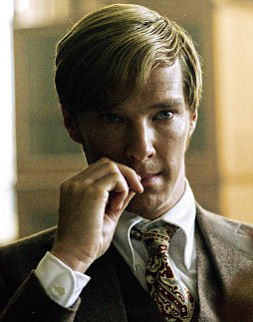 'One of
Peter's contacts, Ricki Tarr (Tom Hardy), comes to him with a claim
that there is a mole operating at the heart of the Circus, and Peter
takes it to the civil servant in charge of the intelligence service.
George Smiley is brought back from retirement to investigate from the
outside, and Peter is his man on the inside.
'One of
Peter's contacts, Ricki Tarr (Tom Hardy), comes to him with a claim
that there is a mole operating at the heart of the Circus, and Peter
takes it to the civil servant in charge of the intelligence service.
George Smiley is brought back from retirement to investigate from the
outside, and Peter is his man on the inside.'It's a crucial relationship in the story and Guillam sacrifices a lot for Smiley, a man he respects enormously and regards almost as a parental figure. Guillam sees Smiley as a man who is trustworthy in an increasingly opaque and slippery moral landscape.'
'John le Carré is an actor's dream. He knew the spying profession well enough to see what it did to human beings, especially men. He really was part of that world, and that's where the authenticity comes in - it's not just the colours or geography or historical accuracy.
'He is a fantastic man—so eloquent and beautiful. Every single nuance of the characters has been thought out, all the back story, and he gives you a very rich and detailed tip of an iceberg.
'We talked about the idea that Guillam would have been a frozen child at one of the military public schools and there would be a distance between him and his parents, partly because of the work he was involved in. Guillam is in love with a man who's older than him, and Smiley is another sort of father figure.
'I've always wanted to play a spy, because it is the ultimate acting exercise. You are never what you seem.
(The Scotsman, Dec 27, 2010, by Siobhan Synnot)
In that sense, he aspires to something more everyman than Fitzwilliam Darcy. At the moment he's filming Tinker, Tailor, Soldier, Spy and is rueful that John Le Carré's Cold War yarn is now regarded by his younger co-stars as history. "I remember the book coming out when I was about 14. I remember it being on TV as an up-to-date and cutting-edge series. But on the set these guys were saying, 'Are we doing a period piece?'"
Does he mind getting older? "When I was about 25, I remember looking at older actors I was working with—brilliant older actors—and thinking, 'I can't wait to get a few wrinkles.' I had such an utterly boring face at that age and longed for a bit of weathering and a bit of texture."
And then he smiles, sang-froid restored. "Just as long as I don't fall apart completely."
(Dec 27, 2010, by TV.com staff)
You are involved with Tinker, Tailor, Soldier, Spy as well, how will that translate to today’s audience do you think?
That’s going to be very interesting. They have this extraordinary cast (Gary Oldman John Hurt, Benedict Cumberbatch, Tom Hardy, Colin Firth, and Toby Jones) and they’re filming in this style that’s very different to what a lot of us have witnessed before. It’s like being observed. You are spies; you are working for MI5—The Circus—but there’s a camera that seems to be spying on you. I think it will be fascinating. You never know how these things end up, but it has the guts of being an extraordinary film.
Whether people will come and see it, that’s a different thing because it’s a highly complex story. The screenplay is pretty complex and it tangentially goes in strange places. There’s a history that goes with it obviously, but there’s something really gripping about it.
(Daily Mail, Nov 5, 2010, by Baz Bamigboye)
Gary Oldman drinks a mug of builder's tea and talks about the art of becoming ace spy-catcher George Smiley—and of laying the ghost of Alec Guinness to rest.
It took Oldman two months before he felt able to sign on to play quietly ruthless intelligence officer Smiley, created in literary form by John le Carre and on the small screen by Alec Guinness in the BBC television drama Tinker, Tailor, Soldier, Spy in 1979.
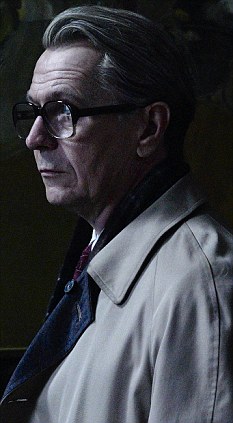 'I
always say "Why me?" on every role,' Oldman confessed as we sat in his
trailer on the set of the first big-screen version of Tinker, while
celebrated director Tomas Alfredson (who made acclaimed psychological
thriller Let the Right One In) and his crew set up the next shot.
'Then, of course, there's the ghost of Alec Guinness. It was
beautifully acted and a very well done television series 30 years ago.
So did I worry about that?
'I
always say "Why me?" on every role,' Oldman confessed as we sat in his
trailer on the set of the first big-screen version of Tinker, while
celebrated director Tomas Alfredson (who made acclaimed psychological
thriller Let the Right One In) and his crew set up the next shot.
'Then, of course, there's the ghost of Alec Guinness. It was
beautifully acted and a very well done television series 30 years ago.
So did I worry about that?'Initially, I was worried. I remember watching it at the time, and rewatched it. Always been a fan of Guinness.
But this was never going to be a carbon copy.' Producer Tim Bevan of Working Title Films, who is producing the film with Robyn Slovo, said he got the sense from Oldman that the actor had decided: 'I'm not going to let this (Guinness's version) be a Boogie Woogie on my shoulder.'
Oldman told me: 'I'm 52. let's say I'm playing 55. There have been many Smileys, so he could be all things. I know in the book he's described as a short fat man, but he can be Denholm Elliott, he can be Alec Guinness, he can be James Mason—and he can be Gary Oldman, I think.'
Preparing for the role, he took himself off to Old Focals, the vintage eyewear store in Pasadena. 'Glasses are funny things. For Smiley, they're iconic. It's like the Aston Martin or the Martini, shaken not stirred. You try on hundreds of pairs over a period of hours and suddenly you find what you're looking for.' He snapped up the authentic Seventies black-rimmed tortoiseshell spectacles and had the Working Title studio copy them.
He met Tinker's author David Cornwell—le Carré is his pseudonym—and found himself observing his mannerisms. 'The way he touched his shirt, spoke and so on. I took all that and used it. I hope he won't mind, but Smiley is in his DNA.'
The film will be based on a scorching screenplay by Bridget O'Connor and Peter Straughan that is faithful to the book, but has a few fabulous surprises of its own.
I mentioned that when I watched Oldman shoot scenes on Maria Djurkovic's radical set (spacious and full of pod-like secret chambers) with John Hurt, Colin Firth, Ciarán Hinds, Toby Jones and David Dencik, it was as if his Smiley had blended into the furniture. Oldman said he tried to keep in mind a passage in the novel where Smiley's errant wife, Lady Ann, describes how Smiley can lower his body temperature and assume the environment of the room. 'He's mild-mannered, quite methodical and perspicacious.'
Observing Alfredson, his cast and crew at work for several hours, I got the sense that great work was being made at a disused barracks. Oldman was clearly having the time of his life playing Smiley. 'I've come in from the cold,' he laughed. 'No! I've come in to the cold, because I live in Los Angeles and it's 80 degrees there.
'It's proper work, and I haven't done that for a long time,' he said. 'I've played some amazing roles and I've had a good run, but this is something else. And it's like coming home. I can't remember the last time I played an Englishman.'
The Tinker film also features Benedict Cumberbatch, Kathy Burke, Tom Hardy, Stephen Graham and Laura Carmichael—who plays the vengeful middle sister Lady Edith in Downton Abbey.
(Daily Mail, Oct 22, 2010, by Baz Bamigboye)
Kathy Burke has come in from the cold and returned to acting to play a brilliant spy-catcher. The award-winning actress will appear in an impressive ensemble led by Gary Oldman, Colin Firth, Tom Hardy and Benedict Cumberbatch in the big-screen version of John le Carré’s classic espionage novel Tinker, Tailor, Soldier, Spy.
In what she called a ‘blinding’ part, Kathy has been on set since Monday playing Connie Sachs, a former Soviet expert who had been forced out of the Secret Intelligence Service, MI6—what le Carré termed ‘The Circus’—because she knew too much. Oldman, playing master spy George Smiley, wants Connie’s knowledge of Soviet comings and goings in London and Moscow to enable him to burrow through dusty operations and flush out a Russian mole whose activities have paralysed the Service.
Burke retired from acting several years ago to concentrate on writing and directing for stage and television. The move stunned fans who had seen her playing Waynetta Slob and Perry the vile teen on Harry Enfield shows on TV, or delivering a searing portrait of a battered pregnant wife in Gary Oldman’s film Nil By Mouth—a role which won her the best actress prize at the Cannes Film Festival.
Connie is so wonderfully different from the kind of female one finds in a Bond movie—which is appropriate, since le Carré always said his Smiley was the anti-James Bond. Blazers and slacks are Connie’s uniform—not Bond-girl bikinis. She lives in an Oxford flat with her grey spaniel Flush, her arthritic hands tackle the Times crossword, she enjoys a bottle of sherry and privately teaches the occasional student. Her mind is like a computer as she conjures up distant memories and ancient secret files on Soviet dogsbodies for Smiley.
Beryl Reid played the part to great acclaim in the 1979 BBC TV adaptation, but the Connie in the movie version will be drawn from how screenwriters Bridget O’Connor (who, sadly, died this week), Peter Straughan and director Tomas Alfredson see her, and of course, Kathy’s interpretation. ‘It will not be an impersonation of Beryl,’ is how Kathy put it.
Producers Tim Bevan, Eric Fellner and Robyn Slovo have been busy putting the final touches to casting. John Hurt will be Control, le Carré’s name for the Circus chief, while Toby Jones will play Percy Alleline. Jones takes over from Mad Men actor Jared Harris, who had to bow out of Tinker, Tailor due to scheduling problems because he’s playing Professor Moriarty in Sherlock Holmes 2 for Guy Ritchie, which is also shooting on locations in London.
(Screendaily, September 23, 2010, by Andreas Wiseman
Working Title today confirmed the cast for Tomas Alfredson’s adaptation of John Le Carre novel Tinker, Tailor, Soldier, Spy, due to shoot at the end of Sept.
Gary Oldman will play lead character George Smiley, with Benedict Cumberbatch, David Dencik, Colin Firth, Stephen Graham, Tom Hardy, Jared Harris, Ciarán Hinds, Svetlana Khodchenkova, Roger Lloyd Pack and Mark Strong, rounding out the cast.
The’ 70s-set spy novel adaptation is written by Peter Straughan and Bridget O’Connor and produced by Working Title’s co-chairmen Tim Bevan and Eric Fellner and Robyn Slovo. Executive producers are Debra Hayward, Liza Chasin, Douglas Urbanski, Peter Morgan and John Le Carre.
StudioCanal are funding Tinker, Tailor and will release the film first in the UK through Optimum on Sept 16, 2011, and then in France and Germany through Kinowelt. StudioCanal are handling international sales for the rest of the world.
Filming will take place in London and on location in Budapest and Istanbul.
Bevan said: “Tomas is one of the most gifted directors in the industry and we are really looking forward to working with him on such anexciting project. The timing is right for a big screen version of Le Carre’s classic novel. It’s great for us to have Tomas onboard who has assembled a stellar cast and will bring a unique vision to the material.”
Mark Strong Added To Tinker, Tailor
(Empire, Sept 20, 2010. by James White)
As if the new adaptation of Tinker, Tailor, Soldier, Spy didn’t already have one of the best ensemble casts to gather on one movie for along time, yet another quality thesp has been added to the roster, in the form of Mark Strong.
Empire's sources suggest that Strong will be playing Jim Prideaux, a Circus agent shot in the back during the failed Operation Testify early on in the story. Prideaux's testimony is a key part of the revelation that there's a mole in the highest echelons of the British Secret Service, with our hero George Smiley then spending the film trying to smoke out the double agent.
...[H]is casting is just another reason we’re now seriously anticipating the latest translation of John Le Carré’s work to the screen before a single frame has been committed to celluloid. But when you have a cast that includes Gary Oldman, Colin Firth, Tom Hardy, Jared Harris, Benedict Cumberbatch (as Peter Guillam) and Ciaran Hinds, all under the direction of Let The Right One In’s Thomas Alfredson, you can understand our feelings. Even though, as The Playlist points outs, Ralph Fiennes and David Thewlis aren’t mentioned. That just makes us think they considered but passed—though the truth of that won’t be known until the thing is actually filming.
And the female contingent has also increased by one (to, er, one announced so far), with Svetlana Khodchenhova signing on to play Russian spy Irina.
Reassuringly, producer Tim Bevan assures fans of the original that the Cold War setting and the plot about Oldman’s George Smiley hunting for a mole within the Secret Service will be maintained, largely at the insistance of Le Carré himself, who will be present on set to provide information and probably cuff actors round the head if they start acting like silly arses.
(Daily Mail, Sept 17, 2010, by Baz Bamigboye)
John le Carré has decreed that the big-screen version of his most famous novel, Tinker Tailor Soldier Spy, starring Gary Oldman and Colin Firth, will remain in the Cold War era and not be updated in any shape or form.
The new movie is now in pre-production and will begin filming soon. For about five minutes, early on during the process of putting the film together, there was talk of shifting the story, about master British intelligence officer George Smiley's hunt for a mole within The Circus (the secret service), from its Seventies timeline.
But le Carré was adamant that it should remain rooted in the Cold War. And screenwriter Peter Morgan has complied. Tim Bevan of Working Title, who is producing the film, told me: 'The television drama with Alec Guinness came out in the late Seventies, when we were still ensnarled in the Cold War. Now the Cold War's gone, we have to recreate it.' He added that le Carré will be around during filming, to keep an eye on things.
Firth, who was in Toronto for the world premiere of The King's Speech, a movie that has emerged (as I predicted) as a leading contender for Oscar and Bafta nominations, has one of the main parts in the gripping spy tale, first published in 1974. He told me how Peter Morgan's screenplay has pared le Carré's novel down.
'He's made it dialogue-free a lot of the time. It's quite masterful. For instance, a tiny hand movement can signify something of great importance, and the nuance in somebody's expression can mean something major.'
Firth explained that he and the film's director, Tomas Alfredson, spoke often about the texture of the piece and wanted to explore the human element.
'What I love about le Carré is that it's more about human motivation than whodunit. The reason why somebody betrays their country is personal and passionate.'
He added that looking back to the Seventies gave the movie a 'film noir-ish' feel.
'It has the same sort of resonance that the Forties had, when viewed from the Seventies. This really feels like a rainy, low-tech London.
'I'm not an expert on the intelligence game, but I know that there's still a lot of low-tech employed because if you are a spy, you don't want to be walking around with your data on a mobile phone or a computer, because it's traceable and hackable. It's reality based, as opposed to James Bond or Mission Impossible, and the thing is, we're fascinated by the basic nuts and bolts of the tradecraft!'
To back up his case, he mentioned the recent spy-swap, and the story of the analyst found dead in a holdall at a safe house in Pimlico.
The film also stars Tom Hardy, Mark Strong, Benedict Cumberbatch and Svetlana Khodchenhova, who will play the role of Russian spy Irina.
Meanwhile, The King's Speech will have a special gala screening at the BFI London Film Festival in October. Public bookings for tickets for all films opens on September 27.
(Variety, July 8, 2010, by Tatiana Siegel)
Ralph Fiennes, Colin Firth, Gary Oldman and Michael Fassbender will star in the espionage thriller "Tinker, Tailor, Soldier, Spy" for Working Title and Studio Canal. Swedish helmer Tomas Alfredson ("Let The Right One In") has already signed on to direct the pic, which will begin lensing in October in London.
Based on John Le Carré's 1974 bestseller, story is set in the aftermath of the Cold War and involves a spy hunt within the highest echelons of the British Secret Intelligence Service. Le Carré's novel also spawned a 1970s Brit TV series that starred Alec Guinness.
Peter Morgan ("Frost/Nixon") penned the adaptation. Tim Bevan and Eric Fellner are producing. Debra Hayward, Liza Chasin, Le Carré and Morgan are exec producing. Hayward will shepherd the project for Working Title.
(Daily Mail, June 3, 2010, by Baz Bamigboye)
Gary Oldman is in negotiations to play the ‘breathtakingly ordinary’ George Smiley, the anti-James Bond, in a bigscreen version of John Le Carré’s Tinker, Tailor, Soldier, Spy. Colin Firth, Michael Fassbender and David Thewlis are in early discussions about playing other vital roles in the film, about a Soviet mole at the heart of what Le Carré called the ‘Circus’—the secret intelligence service MI6.
Going for Oldman is a masterstroke of casting because he has one of those deceptively ordinary yet shapeshifting faces that can be dressed any which way. For the actor, it’s the role of a lifetime to play the MI6 senior agent who has an air of awkwardness and a seemingly absurd demeanour.
But those who have read Le Carré’s Karla trilogy, or watched Alec Guinness’s masterful portrait of Smiley in the 1979 television series, or listened recently to Simon Russell Beale playing the role on BBC radio, all know the Oxford graduate is nobody’s fool. Oldman, best known recently for playing Sirius Black in the Harry Potter films and Commissioner Gordon in Christopher Nolan’s Batman pictures, has met Tomas Alfredson, who will direct from a screenplay by Peter Morgan, writer of The Queen.
Alfredson made the Swedish vampire thriller Let The Right One In. Tinker, Tailor, Soldier, Spy is being made by Working Title and they hope shooting will begin in London and other locations in September.
The key roles Alfredson and the folk at Working Title are focusing on are for star names to play the various intelligence chiefs and bureaucrats who are under suspicion of being a Soviet mole. Could it be Percy Alleline, Roy Bland, Bill Haydon, Toby Esterhase or even Smiley himself?
Other important parts still to be cast are Smiley’s faithless aristocratic wife Lady Ann and Soviet expert Connie Sachs, played on TV, respectively, by Sian Phillips and Beryl Reid.
The detail of the social, class and political layers of Britain were in the seven-part BBC drama and, I’m told, those who have read Morgan’s script have been equally impressed at how he has managed to put the heart and essence of Le Carré’s classic into the screenplay.
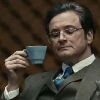 |
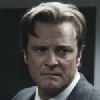 |
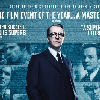 |
|||||
| Teaser
Trailer Caps (updated 6/30/11) |
Production
Stills (updated 8/20/11) |
Poster
Art (updated 9/03/11) |
Please do not upload
any images to
your own website, club, group or community's photo album. Thank you. |
Home |
